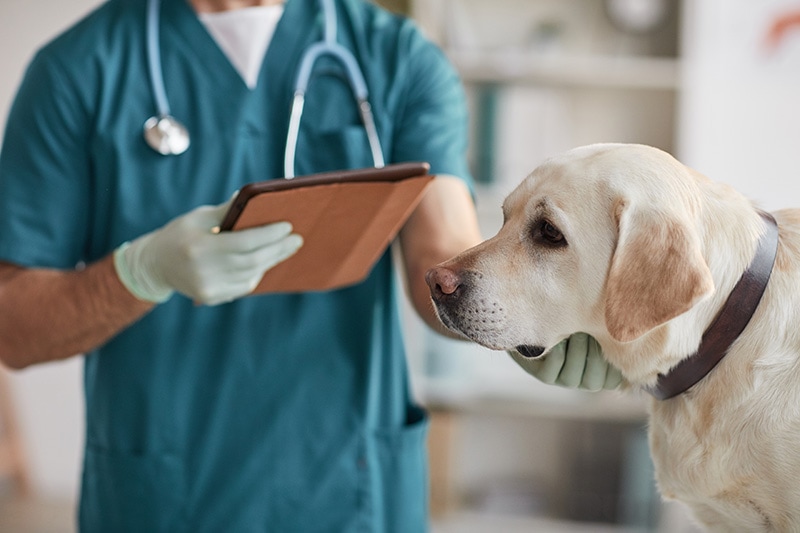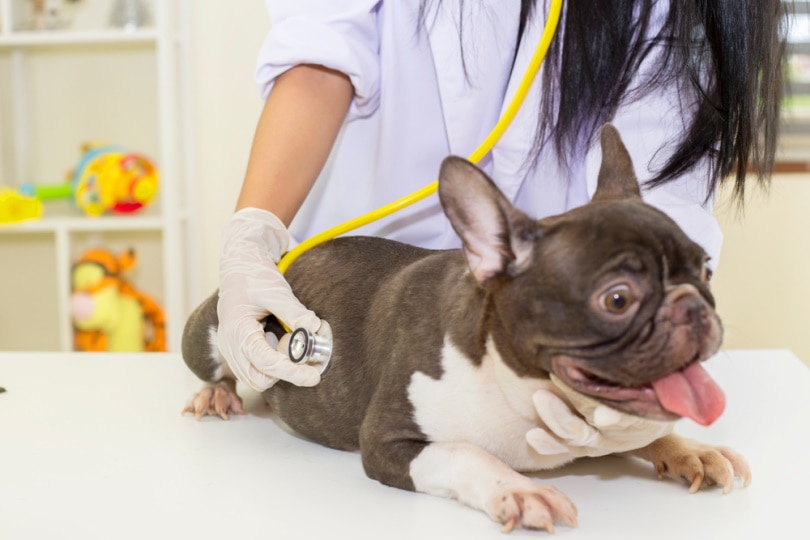7 Most Common Types of Cancers in Dogs (Vet Answer)

Updated on

Click to Skip Ahead
“I’m sorry, but your dog has cancer.” It’s one of the scariest phrases you can hear as a pet owner and one of the most heartbreaking things your veterinary team must tell you. There are many types of cancers, so let’s look at some of the more common ones.
What Is Cancer?
You’ve probably heard the word often, but what exactly is cancer? Cancer is an abnormal growth of cells. Typically, one cell type, such as lymphocytes or bladder call cells, will be affected.
Cancer is one of the most common conditions affecting dogs. One in four dogs will develop cancer in their lifetime1.
Your veterinarian may tell you that a tumor is benign or malignant. A benign growth remains localized and does not spread. These tumors can be quite large, though, and cause their own set of problems.
Malignant cancer has the potential to spread to other areas of the body. The lungs are a common place for cancer to metastasize, so if your veterinarian suspects or diagnoses cancer, they will likely recommend screening X-rays to check for evidence of metastasis.

What Are the Signs of Cancer in Dogs?
Cancer comes in many different forms, so it can present in many ways. Many pet owners first notice a lump or bump on their pet. When you see these, bring it up to your veterinarian. They can perform testing to see what type of mass it is.
Other signs of cancer are less specific and could be associated with other conditions. Anytime you see these problems, you should consult your vet and have your dog examined.
- Unexpected weight loss
- Lethargy
- Change in appetite
- Non-healing wounds
- Chronic diarrhea
- Vomiting
- Enlarged lymph nodes
Keep in mind just because your dog has one or more of these signs, it doesn’t mean they have cancer. They could have hypothyroidism or Cushing’s disease, to name just two possibilities.
The 7 Most Common Types of Cancers in Dogs
1. Lymphoma
Lymphoma is a cancer that arises from specific white blood cells called lymphocytes. Unfortunately, lymphoma is the most common of all the cancers diagnosed in dogs.
What Are the Major Signs of Lymphoma?
Lymphoma can occur anywhere in the body because lymphocytes travel throughout the bloodstream and lymphatic system. Typically, affected dogs have one or more enlarged lymph nodes. There are palpable glands in certain places, like the edge of the jaw and in front of the shoulders, but some are internal and require imaging with an ultrasound or X-rays.
Dogs with cutaneous lymphoma may have skin lesions or lumps. Pets with gastric lymphoma may have chronic vomiting, diarrhea, or even signs of an obstruction. Unfortunately, the signs can be quite varied.
What Is the Treatment for Lymphoma?
It’s important to note that lymphoma is rarely cured in dogs.
Your veterinarian may refer you to an oncologist, who can create a chemotherapy regimen for your dog, depending on the type of lymphoma and what is affected. The most common medications used are Prednisone, Doxorubicin, Cyclophosphamide, and Vincristine.
2. Hemangiosarcoma

Hemangiosarcoma is a particularly scary type of cancer. It occurs within blood vessels, so like lymphoma, it can be found everywhere. The most common site is in the spleen, which is very vascular.
What Are the Major Signs of Hemangiosarcoma?
You may see a new lump if your dog has cutaneous hemangiosarcoma, or your veterinarian may palpate your dog’s abdomen and feel an enlarged spleen.
The sad news is that, with many cases of hemangiosarcoma, the tumor bursts and causes significant and potentially life-threatening blood loss. Your dog could have pale gums, an increased respiratory and heart rate, and weakness.
What Is the Treatment for Hemangiosarcoma?
If there is a discernible tumor, your veterinarian may be able to remove it surgically. A chemotherapy protocol may also be developed for your dog in conjunction with surgery to help your dog for longer, but this is a very malignant type of cancer.
3. Mast Cell Tumor
Mast cell tumors are considered the most common skin masses on dogs. The affected cells, mast cells, carry a large amount of histamine, so some of the signs relate to excessive histamine.
What Are Major Signs of Mast Cell Tumor?
A new lump or bump is the most common sign of a mast cell tumor. These masses can look and feel like anything: they might feel fatty like a lipoma or a little firmer like a skin cyst. That means it’s crucial to test any new lump your dog has.
What Is the Treatment for Mast Cell Tumor?
Your veterinarian will need to surgically remove any mast cell tumor and send it out to a pathologist for histopathology. They will grade the mass to help determine its possible behaviors. A lower-grade mass is more likely to behave like a benign mass, while a high-grade mast cell tumor has more malignant behavior.
Depending on what the mass comes back as (its grade) will determine if chemotherapy or radiation therapy is needed.
4. Osteosarcoma

Osteosarcoma is bone cancer. This type of cancer tends to be painful and aggressive, meaning it can spread to various places.
What Are the Major Signs of Osteosarcoma?
Most pets get diagnosed with osteosarcoma when they come in for limping. They may have a palpable swelling in a bone or joint. It also makes the bone more friable or easier to break, so some dogs have pathologic fractures that develop.
While osteosarcoma can be found in any bone, it is typically localized in bones away from the elbow or near the knee when it is located in the legs.
What Is the Treatment for Osteosarcoma?
The most common treatment for osteosarcoma is amputation of the limb. Your oncologist will help develop a treatment plan, including chemotherapy or radiation.
The prognosis is poor for these dogs, unfortunately. Your veterinarian will try to provide ample pain control with medications like Rimadyl (carprofen) or gabapentin.
5. Mammary Gland Tumors
Mammary gland tumors can be benign or malignant. Any dog is at risk for developing them, but they occur more commonly in unspayed female dogs or females spayed later in life.
What Are the Major Signs of Mammary Gland Tumors?
You’re most likely going to see a lump grow that is associated with the mammary glands. Some dogs have more than one because malignant masses can spread. (The mammary chains communicate up and down and from side to side.)
These masses can get quite large, and if their blood supply is compromised, they may ulcerate and even become necrotic.
What Is the Treatment for Mammary Gland Tumors?
The typical recommendation for dealing with mammary glands is surgical removal. If multiple masses are present, your veterinarian may recommend a chain mastectomy, where one or both whole mammary chains are removed.
Your vet should submit the masses to the pathologist to determine if they are benign or malignant growths. Further therapy, such as chemotherapy or radiation, depends on the histopathology report.
6. Melanoma
Melanomas arise from pigmented cells. The three most common places for melanoma to occur are:
- Within the mouth
- Adjacent to toenails
- Associated with footpads
What Are the Major Signs of Melanoma?
Many melanomas are found within the mouth, so your veterinarian may see them when performing a physical exam or a dental cleaning under anesthesia. You might notice it if your dog has trouble chewing or drooling, particularly from one side of the mouth.
What Is the Treatment for Melanoma?
Veterinarians typically perform surgery to treat melanoma in dogs. It can be a challenging procedure, especially if the mass is large and in the mouth. Your veterinarian may also refer your dog for radiation therapy.
A newer treatment for melanoma in dogs is an anti-melanoma vaccine or other immune therapies. Your oncologist can tell you if it might benefit your dog.
7. Transitional Cell Carcinoma

Transitional cell carcinoma is the most common bladder cancer in dogs. It is malignant and may have a genetic component, given that some breeds, like Scottish Terriers, are at a higher risk for developing it. Other breeds that seem to be affected more commonly than others include:
- Shetland Sheepdogs
- West Highland White Terriers
- Dachshunds
What Are Major Signs of Transitional Cell Carcinoma?
Transitional cell carcinoma can present just like a urinary tract infection. It sometimes clues your veterinarian to look deeper if your dog has recurrent UTI symptoms.
Affected dogs may have bloody urine, with or without evidence of a UTI. They might strain to urinate because the tumor is blocking part of the bladder or urethra. Your dog may have to urinate frequently.
What Is the Treatment for Transitional Cell Carcinoma?
Surgery is rarely effective for dogs as a treatment for transitional cell carcinoma because it may make your dog incontinent. It also infrequently cures the cancer. Some dogs with signs of an obstruction benefit from a urethral stent.
Your veterinarian will likely treat your dog’s bladder cancer with medication, usually a combination of chemotherapy and anti-inflammatories like piroxicam.
Unfortunately, this cancer is typically fatal. The cancer can metastasize, but it usually grows larger until it obstructs the bladder or urethra. It may also cause kidney failure.
Frequently Asked Questions
What is the first sign of cancer in dogs?
The first sign of cancer is usually a new lump on your dog. This lump could be a skin mass, or it could be one of the peripheral lymph nodes that have become enlarged, such as with lymphoma.
Not all cancer is evident by a discernible mass. Sometimes, you’ll notice that your dog is losing weight or less energetic than they used to be. If you’re noticing changes in your dog, it’s worth mentioning to your veterinarian.
Is cancer in dogs painful?
Cancer can be a very painful condition. When the cancer is small and not impinging on other organs, it may not bother your dog. Cancers can become quite inflamed and ulcerated, making them a source of infection as well as pain.
Certain cancers, such as osteosarcoma, can weaken the bones. Weaker bones are more likely to break, even if your dog is just walking across a flat surface, let alone jumping on or off the couch. Fractures are incredibly painful.
Cancer can also cause secondary signs in your dog that can be very distressing–for you and for your dog. Many cancers metastasize to the lungs, where they make it harder for your dog to breathe.
Conclusion
Hearing that your dog has cancer is scary. Your veterinarian can help you review your dog’s options or refer you to an oncologist who can help answer your questions.
Featured Image Credit: SeventyFour, Shutterstock













